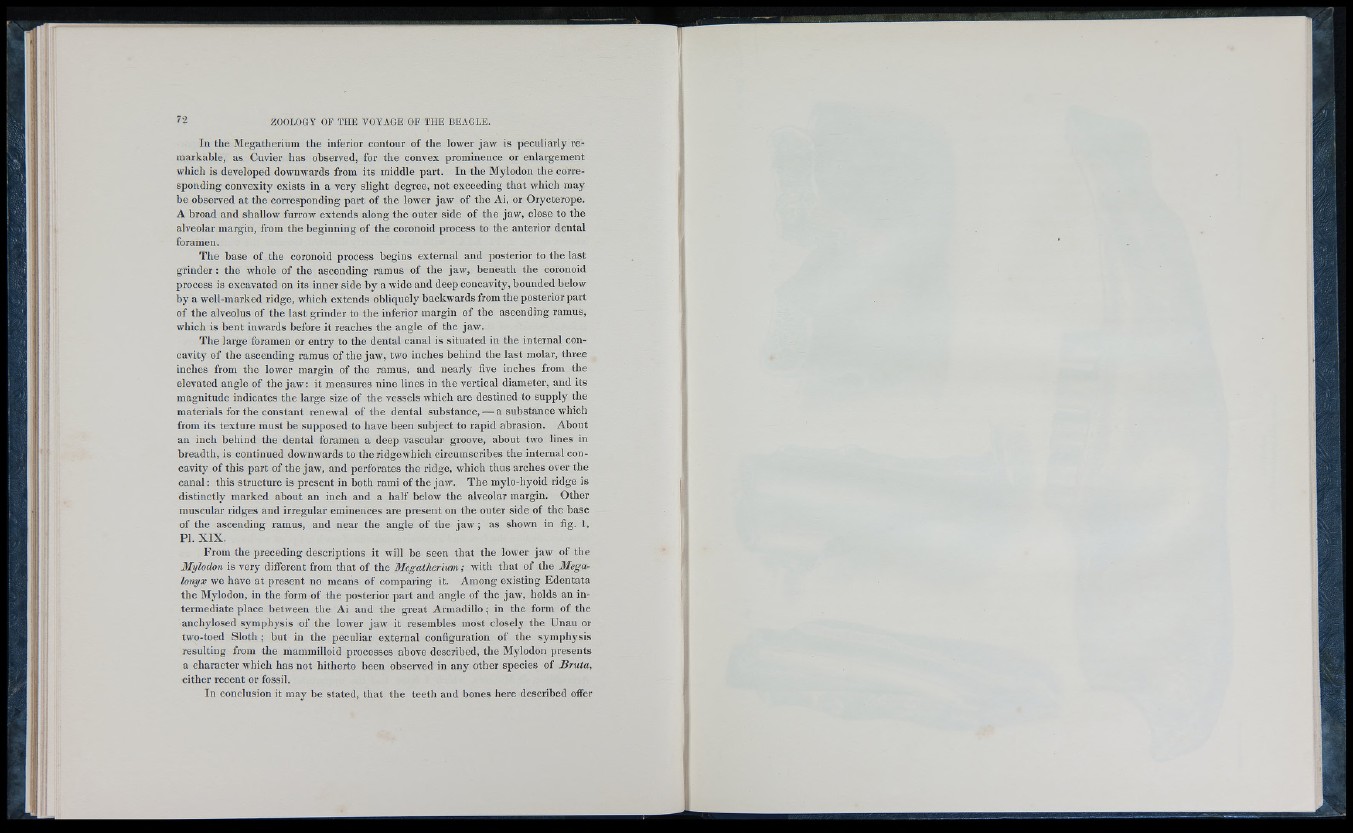
Ill the Megatherium the inferior contour of the lower jaw is peculiarly remarkable,
as Cuvier has observed, for the convex prominence or enlargement
which is developed downwards from its middle part. In the Mylodon the corresponding
convexity ex ists in a very slight degree, not exceeding that -which may
be observed at the corresponding part o f the lower jaw o f the Ai, or Orycterope.
A broad and shallow furrow extends along the outer side o f the jaw, close to the
alveolar margin, from the beginning o f the coronoid process to the anterior dental
foramen.
The base o f the coronoid process begins external and posterior to the last
grinder : the whole o f the ascending ramus o f the jaw, beneath the coronoid
process is excavated on its inner side b y a w ide and deep concavity, bounded below
by a well-marked ridge, which extends obliquely backwards from the posterior part
o f the alveolus o f the la st grinder to the inferior margin o f the ascending ramus,
whicli is bent inwards before it reaches the angle o f the jaw.
The large foramen or entry to the dental canal is situated in the internal concavity
o f the ascending ramus o f the jaw, two inches behind the la st molar, three
inches from the lower margin o f the ramus, and nearly five inches from the
elevated angle o f the jaw ; it measures nine line s in the vertical diameter, and its
magnitude indicates the large size o f the v e sse ls which are destined to supply the
materials for the constant renewal o f the dental substance, — a substance which
from its texture must be supposed to have been subject to rapid abrasion. About
an inch behind the dental foramen a deep vascular groove, about two lines in
breadth, is continued downwards to the ridge which circumscribes the internal concavity
o f this part o f the jaw, and perforates the ridge, which thus arches over the
c a n a l: this structure is present in both rami o f the jaw. T h e mylo-hyoid ridge is
distinctly marked about an inch and a ha lf below the alveolar margin. Other
muscular ridges and irregular eminences are present on the outer side o f the base
o f the ascending ramus, and near the angle o f the jaw ; as shown in fig. 1,
PL X IX .
From the preceding descriptions it will be seen that the lower jaw o f the
JMylodoii is very different from that o f the Megatherium; with that o f the Megalonyx
we have at present no means o f comparing it. Among ex isting Edentata
the Mylodon, in the form o f the posterior part and angle o f the jaw, holds an in termediate
place between the Ai and the great Armad illo ; in the form o f the
anchylosed symphysis o f the lower jaw it resembles most closely the Unau or
two-toed Sloth ; but in the peculiar external configuration o f the symphysis
resulting from the mammilloid processes above described, the Mylodon presents
a character whicli has not hitherto been observed in any other spe cie s o f Bruta ,
either recent or fossil.
In conclusion it may be stated, that the teeth and bones here described offer